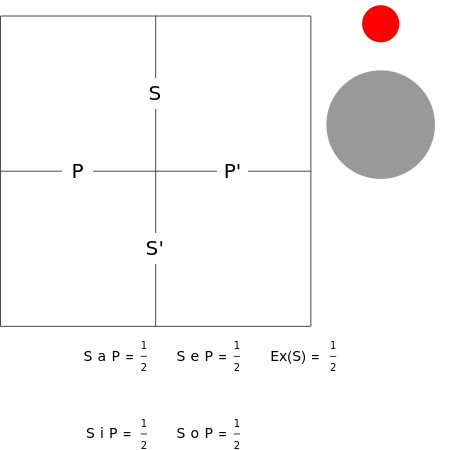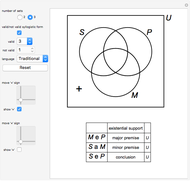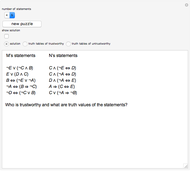Lewis Carroll's Bilateral Diagram

Requires a Wolfram Notebook System
Interact on desktop, mobile and cloud with the free Wolfram Player or other Wolfram Language products.
Aristotelian logic, or the traditional study of deduction, deals with four so-called categorical or subject-predicate propositions, which can be defined by: S a P ⇔ All S is P (universal affirmative or A proposition), S i P ⇔ Some S is P (particular affirmative or I proposition), S e P ⇔ No S is P (universal negative or E proposition), S o P ⇔ Some S is not P (particular negative or O proposition).
[more]
Contributed by: Izidor Hafner (March 2011)
Open content licensed under CC BY-NC-SA
Snapshots
Details
A diagram showing the relations among categorical propositions is known as the traditional square of opposition [2, p. 217]. Two propositions are contradictories if one is the negation of the other. Propositions A and O, and propositions I and E are contradictories. Two propositions are contraries if they cannot both be true. Two propositions are subcontraries if they cannot both be false. Proposition A is called superaltern, I is called subaltern, and the coresponding relation is called subalternation. The same definitions are aplied to E and O [2, pp. 214-217]. Under the assumption that class S is not empty, propositions A and E are contraries, propositions I and O are subcontraries, and superaltern implies subaltern.
[1] L. Carroll, Symbolic Logic and The Game of Logic, New York: Dover, 1958.
[2] I. M. Copi and C. Cohen, Introduction to Logic, 9th ed., New York: Macmillan, 1994 pp. 214-218.
Permanent Citation
"Lewis Carroll's Bilateral Diagram"
http://demonstrations.wolfram.com/LewisCarrollsBilateralDiagram/
Wolfram Demonstrations Project
Published: March 7 2011



































